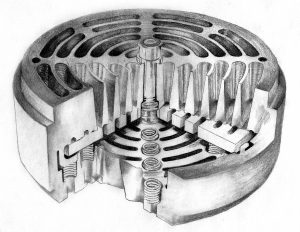Valve (Reciprocating Compressor)

A specially designed check valve used to control the gas flow into and out of a compressor cylinder.
The most common compressor valve designs are:
- Plate Valve – A reciprocating compressor cylinder valve design similar to the ring valve design, but with concentric rings connected by radial ribs. Instead of individual elements opening and closing, the entire valve plate lifts when sufficient differential pressure is present to lift it from the valve seat, simultaneously opening all valve ports. Plate valves are designed to withstand high pressure and dirty gas applications.
- Poppet Valve – A reciprocating compressor valve, comprised of multiple poppet valves, are typically used for low compression ratio applications, such as pipeline booster compressors. Each poppet is normally held in the closed position with a spring. As the pressure differential increases during the compression stroke, the individual poppets lift and allow gas to pass through the flow openings in the stop plate.
- Ring Valve – A reciprocating compressor cylinder valve, typically recommended for use in slow speed (less than 600 rpm), high differential pressure (up to 30 Mpa [4350 psi]), or high discharge pressure applications (up to 60 Mpa [8700 psi]). Ring valves are comprised of one or more narrow sealing rings arranged concentrically about the center line of the valve. These valves have the advantage of a low-stress levels due to the lack of stress concentration points. An inherent disadvantage of a ring valve is its difficulty to maintain uniform valve flow control due to the independent sealing rings.
